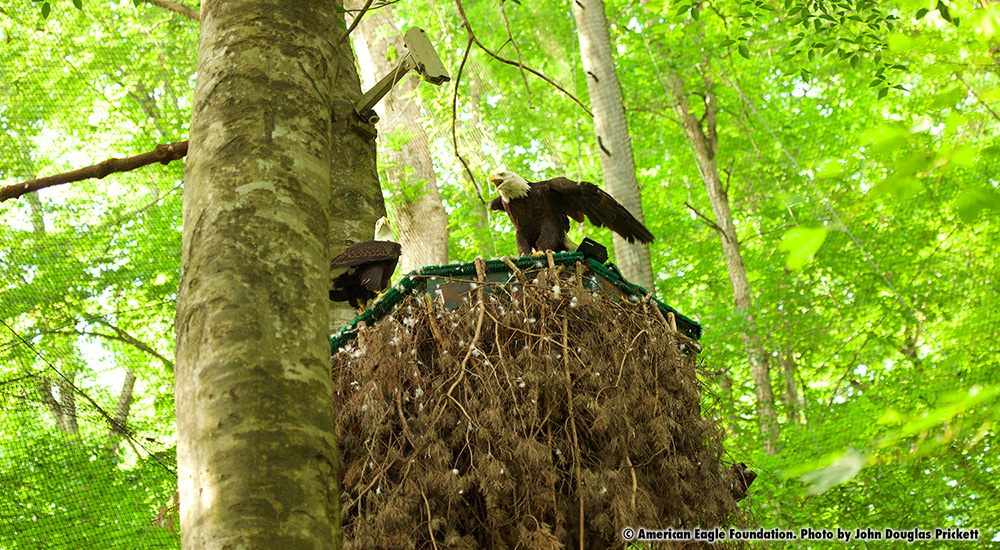The Three AEF Pillars:
Conserve, Educate, and Protect
The American Eagle Foundation’s mission is divided into what we call the three AEF pillars: conservation, education, and protection. This page will provide an overview of each of these with additional information found throughout our website. If you would like to support the AEF’s mission, please check out our Donation page or contact us!
Conserve

The U.S. Fish and Wildlife, state agencies, conservation groups, and like-minded individuals must all do their part in protecting the bald eagle. One might say, “I know there are Federal and State laws in place to protect eagles, but what can I, as an individual, do to help?”
Actions include, but are not limited to the following:
- Protect eagle habitats. Notify your local state wildlife agency if you notice a disturbance of an eagle nest habitat area by an individual or a corporation.
- Keep safe distances from their nests and roost site so as not to disturb eagles.
- If a nest is blown from a tree, help monitor and protect the area for up to 3 complete breeding seasons. Many eagles will rebuild the same nest, or build a nest close by.
- Advocate for eagle friendly power lines in areas where eagles are present; write to your government officials to lobby against indiscriminate wind-turbines that kill thousands of eagles; avoid harmful pesticides that contaminate the environment and threaten wildlife.
- Landfill areas should immediately cover carcasses of euthanized animals to avoid other animals such as eagles being poisoned by them.
- Hunt and fish responsibly—do not ever use lead shot or fishing apparatus.
The American Eagle Foundation’s mission to keep America’s eagles flying strong and free includes the pillar of Conservation and Protection. Specifically, we engage in non-releasable bird care, Bald Eagle protection & advocacy, and creating & managing a Nest Egg Fund in order to maintain AEF programs designed to help the Bald Eagle.
Educate
“In the end, we conserve only what we love. We will love only what we understand. We will understand only what we are taught.”
Those words are as appropriate today as they were when Baba Dioum first spoke them in 1968 at the International Union for the Conservation of Nature and Natural Resources.
In the 21st century, we are drowning in information, but lacking in wisdom. We need environmental advocates who can synthesize information intelligently, and present it in a way that is appealing and easy to understand.
The American Eagle Foundation lists Education as one if its 3 pillars upon which its Mission is based. To accomplish this, we present our live video HD cams on several bald eagle nests, where adults and children can watch eagle families go about their daily activities while caring for their young. An online Chat is featured, whereby those watching the eagles can ask questions or share observations with others. This Chat is monitored by Moderators and Cam Operators—individuals immersed in eagle knowledge, who welcome and help inform those who visit. Our moderators also encourage teachers to set up a scheduled viewing time just for their class, so the students can ask all the questions they want in a friendly, welcoming environment.
Our viewers can, without disturbing one eagle, see the lives of these magnificent creatures unfold from the comfort of their classrooms, computer rooms – or even their mobile devices.
In addition, AEF carries its outreach programs into hospitals, nursing homes, classrooms, parks, and corporate events with Birds of Prey shows featuring many of our non-releasable raptors (the stars of the show.) The caregiver/handlers of these birds are knowledgeable and entertaining, and delight their audiences with stories unique to each bird and the species it represents.
At Dollywood, our Wings of America birds of prey show has educated millions of visitors, while providing a fast-paced, always entertaining hour of fun.
Challenger, the non-releasable, free-flying bald eagle has performed thousands of soul-stirring flights over stadiums and corporate events. He has inspired Senators and House Members; visited with the Secretary of the Interior, and even met United States Presidents. He has appeared on national TV shows and is undoubtedly the world’s most recognized bald eagle. Although Challenger retired from free flights in 2019, he continues to advocate for his species, raising awareness about the bald eagle and what it stands for.
It is up to every one of us to be torchbearers for the future; to speak for the animals; to protect the planet for generations yet to come.
Protect

An injured Osprey receives a fresh bandage.
The AEF receives anywhere from 10-50 injured or sick raptors annually for rehabilitation.
In addition to the treatment of injured, sick, and orphaned eagles, AEF’s Eagle rehabilitation qualification is an important factor to its successfully daily care of brooding eagles, their young, and eagles being hacked for release.
The American Eagle Foundation works closely with Dr. Mike Jones, DVM (who specializes in Raptor Biomedicine and Avian Emergency Medicine and Critical Care) and the UT College of Veterinary Medicine to ensure the health of the AEF’s resident raptors and also to successfully rehabilitate injured wild birds of prey.
UT College of Veterinary Medicine provides vital care birds of prey with life-threatening or vital injuries then transfers them to the AEF for daily care and rehabilitation.
The AEF has a quarantine facility for incoming raptors, a rehab facility for daily care, a flight facility for bald eagles to rebuild their flight ability after rehabilitation, and a smaller flight facility for small to medium sized raptors, such as owls and hawks.
Once an injured raptor completes its rehabilitation, it is released back into the wild, ideally close to where it was found. Raptors who have sustained injuries that render them incapable of survival in the wild are given a forever home at the AEF or another raptor facility.
Rehabilitation is overseen by the AEF’s Rehab Manager, Nancy Zagaya.
